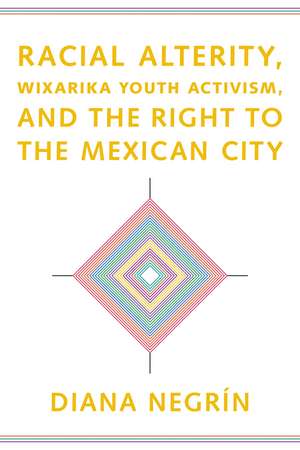Racial Alterity, Wixarika Youth Activism, and the Right to the Mexican City
Autor Diana Negrínen Paperback – 5 noi 2024
While the population of Indigenous peoples living in Mexico’s cities has steadily increased over the past four decades, both the state and broader society have failed to recognize this geographic heterogeneity by continuing to expect Indigenous peoples to live in rural landscapes that are anathema to a modern Mexico.
This book examines the legacy of the racial imaginary in Mexico with a focus on the Wixarika (Huichol) Indigenous peoples of the western Sierra Madre from the colonial period to the present. Through an examination of the politics of identity, space, and activism among Wixarika university students living and working in the western Mexican cities of Tepic and Guadalajara, geographer Diana Negrín analyzes the production of racialized urban geographies and reveals how Wixarika youth are making claims to a more heterogeneous citizenship that challenges these deep-seated discourses and practices. Through the weaving together of historical material, critical interdisciplinary scholarship, and rich ethnography, this book sheds light on the racialized history, urban transformation, and contemporary Indigenous activism of a region of Mexico that has remained at the margins of scholarship.
This book examines the legacy of the racial imaginary in Mexico with a focus on the Wixarika (Huichol) Indigenous peoples of the western Sierra Madre from the colonial period to the present. Through an examination of the politics of identity, space, and activism among Wixarika university students living and working in the western Mexican cities of Tepic and Guadalajara, geographer Diana Negrín analyzes the production of racialized urban geographies and reveals how Wixarika youth are making claims to a more heterogeneous citizenship that challenges these deep-seated discourses and practices. Through the weaving together of historical material, critical interdisciplinary scholarship, and rich ethnography, this book sheds light on the racialized history, urban transformation, and contemporary Indigenous activism of a region of Mexico that has remained at the margins of scholarship.
Preț: 229.55 lei
Nou
Puncte Express: 344
Preț estimativ în valută:
43.93€ • 47.70$ • 36.90£
43.93€ • 47.70$ • 36.90£
Carte indisponibilă temporar
Doresc să fiu notificat când acest titlu va fi disponibil:
Se trimite...
Preluare comenzi: 021 569.72.76
Specificații
ISBN-13: 9780816555307
ISBN-10: 0816555303
Pagini: 240
Ilustrații: 14 b&w illustrations
Dimensiuni: 152 x 229 mm
Greutate: 0.45 kg
Editura: University of Arizona Press
Colecția University of Arizona Press
ISBN-10: 0816555303
Pagini: 240
Ilustrații: 14 b&w illustrations
Dimensiuni: 152 x 229 mm
Greutate: 0.45 kg
Editura: University of Arizona Press
Colecția University of Arizona Press
Notă biografică
Diana Negrín is a native of Guadalajara, Jalisco, and the San Francisco Bay Area. Negrín received her doctorate from the Department of Geography at the University of California, Berkeley; she is a professor at the University of San Francisco and president of the Board of Directors of the Wixarika Research Center.
Cuprins
List of Illustrations
Acknowledgments
List of Abbreviations
Introduction: Negotiating Expectations, Articulating Identities in Urban Mexico
1. The Long Arc of Indigenismo: Mapping Vision, Race, and Nation
2. Acción Indigenista and the Development of Wixarika Territory
3. Tepic: City of Inclusion, City of Exclusion
4. Guadalajara de Indias: Searching for the Right to the Citybr /> 5. Makuyeika: She Who Walks in Many Places
Conclusion: Walking Together
Notes
References
Index
Acknowledgments
List of Abbreviations
Introduction: Negotiating Expectations, Articulating Identities in Urban Mexico
1. The Long Arc of Indigenismo: Mapping Vision, Race, and Nation
2. Acción Indigenista and the Development of Wixarika Territory
3. Tepic: City of Inclusion, City of Exclusion
4. Guadalajara de Indias: Searching for the Right to the Citybr /> 5. Makuyeika: She Who Walks in Many Places
Conclusion: Walking Together
Notes
References
Index
Recenzii
"Well-written and highly readable, the book is a compelling work of scholarship that should appeal to a wide range of readers interested in Mexico, urban geography, and indigenous studies."—Joe Bryan, Journal of Historical Geography
“Racial Alterity, Wixarika Youth Activism, and the Right to the Mexican City examines racial alterity in urban Mexico. By mapping Indigenous belonging as a cultural, geographic, and historical process, this book illuminates how Mexico’s cities are racialized to become spaces of inclusion and exclusion.”—M. Bianet Castellanos, co-editor of Comparative Indigeneities of the Américas: Toward a Hemispheric Approach
“In Racial Alterity, Wixarika Youth Activism, and the Right to the Mexican City Diana Negrín offers an important contribution to our understanding of urban indigeneity in contemporary Mexico. Her interdisciplinary approach brings together colonial history, postcolonial state making, and Indigenous geographies in a beautifully written account of how Wixaritari university students and professionals in Nayarit and Jalisco experience the promises (met and unmet) of neoliberal multiculturalism.”—Maurice Rafael Magaña, Mexican American Studies, University of Arizona
“Racial Alterity, Wixarika Youth Activism, and the Right to the Mexican City examines racial alterity in urban Mexico. By mapping Indigenous belonging as a cultural, geographic, and historical process, this book illuminates how Mexico’s cities are racialized to become spaces of inclusion and exclusion.”—M. Bianet Castellanos, co-editor of Comparative Indigeneities of the Américas: Toward a Hemispheric Approach
“In Racial Alterity, Wixarika Youth Activism, and the Right to the Mexican City Diana Negrín offers an important contribution to our understanding of urban indigeneity in contemporary Mexico. Her interdisciplinary approach brings together colonial history, postcolonial state making, and Indigenous geographies in a beautifully written account of how Wixaritari university students and professionals in Nayarit and Jalisco experience the promises (met and unmet) of neoliberal multiculturalism.”—Maurice Rafael Magaña, Mexican American Studies, University of Arizona
Descriere
Utilizing archival and ethnographic research, this book explores the construction of racial and ethnic imaginaries in the western Mexican cities of Guadalajara and Tepic, and the ways in which these imaginaries shape the contemporary experiences and activism of Wixarika (Huichol) Indigenous university students and professionals living, studying, and working in these two cities.
